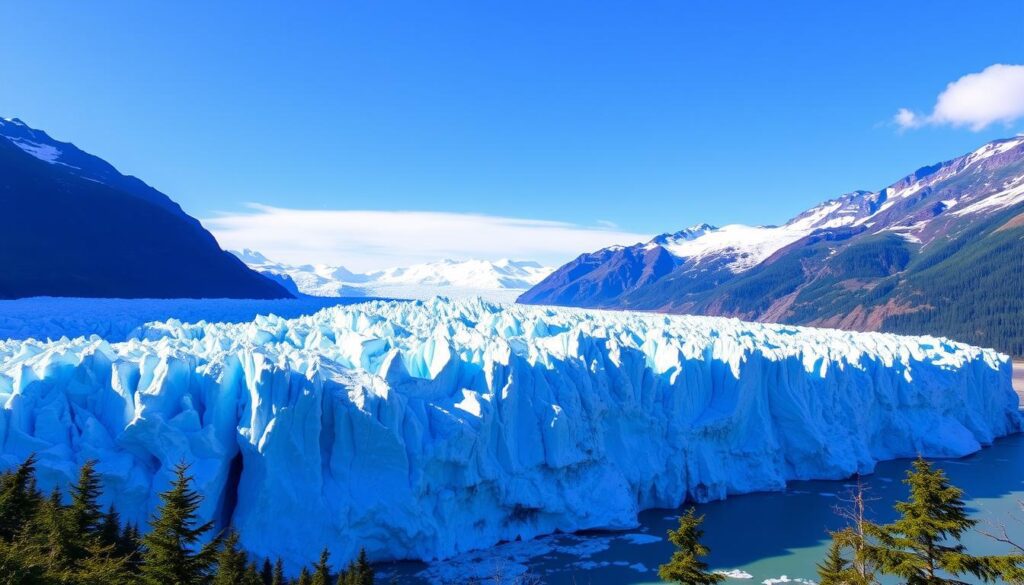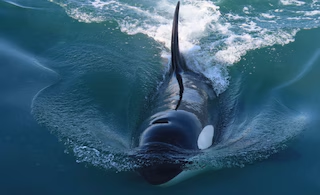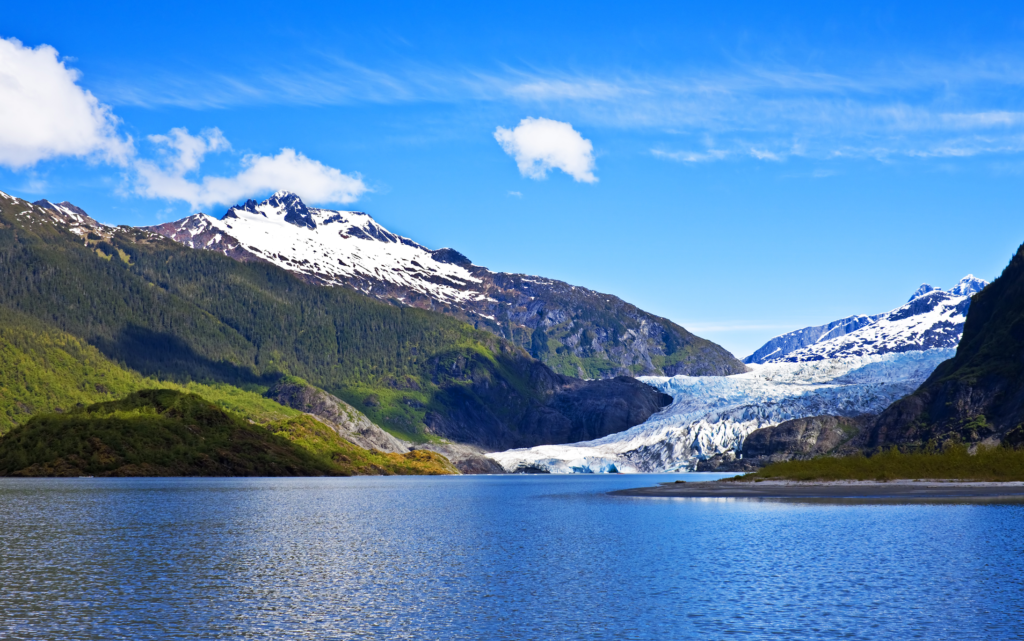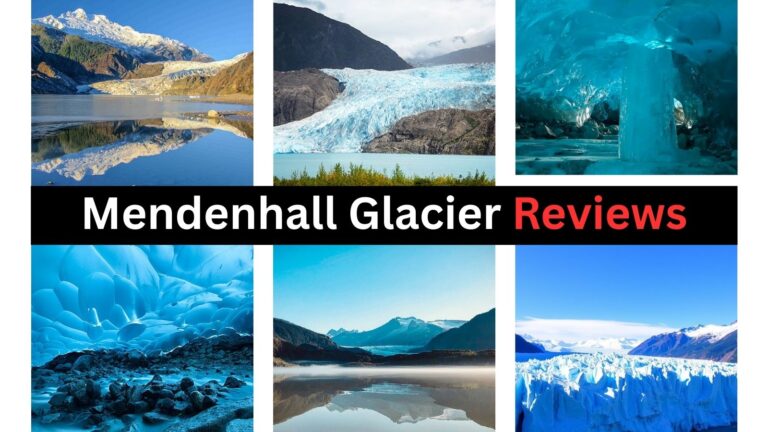Introduction to Mendenhall Glacier
Nestled in the breathtaking Mendenhall Valley, just a short drive from downtown Juneau, Alaska, lies the magnificent Mendenhall Glacier. As a 13.6-mile-long river of ice, it is one of the most accessible and unique glaciers in North America, drawing hundreds of thousands of visitors each year.
Why it’s Famous and Unique
Mendenhall Glacier stands out for a few key reasons. Unlike most glaciers in Alaska, which require a boat, plane, or helicopter to see, Mendenhall is easily reached by road. This remarkable accessibility allows visitors to walk right up to the lake in front of the glacier and explore a network of trails, including one to the spectacular Nugget Falls. Its vibrant blue ice, caused by the compression of snow and the absorption of light, provides a stunning contrast to the surrounding landscape. The glacier is also part of the larger Juneau Icefield, a vast, 1,500-square-mile expanse of ice that feeds 38 major glaciers.
Quick Facts
- Size: The glacier is approximately 13.6 miles (21.9 km) long and 1.5 miles (2.4 km) wide at its terminus.
- Age: Mendenhall Glacier is a remnant of the “Little Ice Age,” a cooler period that began approximately 3,000 years ago.
- Accessibility: It is the only glacier in the Juneau area accessible by road, making it a popular destination for travelers arriving by cruise ship or plane. The Mendenhall Glacier Visitor Center and surrounding trails offer excellent views, with some even being wheelchair-accessible.
Table of Contents
History and Formation of Mendenhall Glacier
The story of Mendenhall Glacier is a dynamic one, written in ice over thousands of years and shaped by both natural forces and a changing climate.
Geological Background
Mendenhall Glacier is a remnant of the “Little Ice Age,” a cooler period that occurred between approximately the 14th and 19th centuries. It flows from the southern half of the Juneau Icefield, one of North America’s largest icefields. The glacier formed as a result of thousands of years of accumulated snowfall that compacted under immense pressure, turning into solid glacial ice. This massive river of ice has been a powerful force, carving the U-shaped Mendenhall Valley, gouging the bedrock, and creating the stunning landscape we see today. The Mendenhall Lake, which is a proglacial lake, only began to form around 1929 as the glacier started its significant retreat.
Native Cultural Significance
The area around Mendenhall Glacier has been the ancestral home of the Aak’w Kwáan Tlingit people for centuries. They have a deep cultural connection to the land and the glacier, which they originally named “Sítʼ Aantʼaakú,” meaning “The Glacier Behind the Town.” The Tlingit have traditional stories and songs that speak of their relationship with the glacier, and a recent co-stewardship agreement between the Central Council of the Tlingit & Haida Indian Tribes and the U.S. Forest Service aims to bring more of this rich cultural history to visitors.
Evolution Over Time
Since the end of the Little Ice Age in the mid-1700s, Mendenhall Glacier has been in a state of continuous retreat. It has receded approximately 2.5 miles (4.0 km) since 1500, with an accelerating pace in recent decades. The melting of the glacier has created Mendenhall Lake, which is increasing in size as the ice continues to retreat. This ongoing process is a clear visual example of the effects of a warming climate. In 2012, the retreating ice even uncovered ancient tree stumps and logs that are between 1,400 and 2,350 years old, providing scientists with a unique window into the past ecosystem of the valley before the glacier advanced.
How to Get to Mendenhall Glacier
One of the great advantages of visiting Mendenhall Glacier is its accessibility. Located approximately 12 miles (19 km) from downtown Juneau, there are several transportation options to get you to the Mendenhall Glacier Visitor Center.
Directions from Downtown Juneau
If you have a rental car or are taking a taxi, the drive from downtown Juneau is straightforward. You’ll take Egan Drive and then turn onto Mendenhall Loop Road, which leads directly to the Mendenhall Glacier Recreation Area. The drive typically takes about 20-30 minutes, depending on traffic. Once there, you will find ample parking.
Cruise Ship Passenger Tips
For those arriving via cruise ship, there are a few convenient options:
- Shuttle Buses: Numerous private shuttle bus companies operate from the cruise ship docks, offering a quick and direct round-trip service to the Mendenhall Glacier Visitor Center. These are a popular and hassle-free option for cruise passengers, and tickets can often be purchased directly at the dock or booked in advance. The journey usually takes around 30 minutes each way.
- Cruise Line Excursions: Your cruise line will offer a variety of excursions that include a visit to the glacier, sometimes in combination with other activities like whale watching or a city tour. These tours provide the convenience of direct transportation and a guaranteed return to your ship.
Transportation Options (Car, Bus, Tours)
- Rental Car: Renting a car gives you the most flexibility to explore Mendenhall Glacier and other areas of Juneau at your own pace.
- Public Bus: The public bus system, Capital Transit, offers a more budget-friendly option. However, it’s important to note that the bus does not go directly to the visitor center. The closest bus stop is about 1.5 miles (2.4 km) away, requiring a walk along a scenic path to reach the glacier. The bus ride itself can take up to an hour.
- Tours: In addition to the standard shuttle services, you can book guided tours that provide transportation and a more structured experience. These tours often include a guide who will offer commentary on the history, geology, and wildlife of the area. Some tours also include access to specialized activities like guided hikes, kayaking on Mendenhall Lake, or even helicopter landings on the glacier itself.
Things to Do at Mendenhall Glacier
Mendenhall Glacier is more than just a place to see; it’s a place to experience. The Mendenhall Glacier Recreation Area offers a range of activities, from educational exhibits to a variety of hiking trails.
1. Mendenhall Glacier Visitor Center
The Visitor Center is the heart of the Mendenhall Glacier experience. It is operated by the U.S. Forest Service and offers a comfortable and comprehensive way to learn about the glacier and the surrounding environment.
- Exhibits and Educational Displays: Inside, you’ll find world-class, museum-quality exhibits that explain the glacier’s geological history, the science of its retreat, and its impact on the local ecosystem. A 15-minute film plays on a loop, offering a dynamic overview of the glacier’s formation and its connection to the vast Juneau Icefield.
- Viewing Platforms and Photo Spots: The main viewing platform is located just outside the Visitor Center, offering a spectacular, panoramic view of the glacier as it terminates into Mendenhall Lake. This is a perfect spot for photos, with the majestic ice and surrounding mountains as a backdrop. Additional viewing platforms are found along the nearby trails.
2. Hiking Trails Around Mendenhall Glacier
A network of well-maintained trails caters to all fitness levels, allowing you to immerse yourself in the natural beauty of the area.
- Nugget Falls Trail: This is one of the most popular trails, a relatively easy, flat, and well-maintained 2-mile round-trip walk. The trail meanders along the shore of Mendenhall Lake, offering stunning views of the glacier. It culminates at the base of the spectacular Nugget Falls, a powerful, 377-foot waterfall that cascades into the lake. You can feel the spray from the falls and get a close-up view of the glacier’s terminus from the rocky beach.
- Photo Point Trail: A short, paved, and fully accessible trail, this is the quickest way to get a head-on view of the glacier. The trail is about one-third of a mile round-trip and leads to an excellent viewing platform directly across the lake from the glacier’s face.
- East Glacier Loop Trail: For those looking for a more immersive hiking experience away from the crowds, the East Glacier Loop Trail is a great option. This 3.5-mile loop (one way from the visitor center) has a gradual elevation gain and leads through old-growth temperate rainforest, offering elevated views of the glacier, Nugget Falls, and the surrounding terrain.
- West Glacier Trail (for experienced hikers): Located on the opposite side of Mendenhall Lake, the West Glacier Trail is a more challenging and strenuous hike. This is a multi-mile, one-way trail with uneven, rocky terrain that leads to a rocky outcrop with a spectacular, up-close view of the glacier. This trail requires good balance, stamina, and proper hiking gear. It is not recommended for casual hikers.
Wildlife Viewing at Mendenhall Glacier
The Mendenhall Glacier Recreation Area is not only a geological wonder but also a thriving habitat for a variety of Alaskan wildlife. The glacier’s retreat has created new ecosystems that attract diverse species, offering unique viewing opportunities.
- Black Bears, Mountain Goats, Porcupines: The area is a prime location for spotting black bears, particularly during the summer and early fall. The bears are drawn to the creeks to feast on the annual salmon runs. While brown bears also live in the area, they tend to avoid the more heavily trafficked areas, making black bears the more common sight. Look for them foraging along the trails or near the creeks. Binoculars are highly recommended for spotting other animals like mountain goats, which can often be seen as small white dots scaling the steep, rocky cliffs surrounding the valley. Porcupines, beavers, and river otters are also known to frequent the area.
- Bird Watching Opportunities: The Mendenhall Glacier area is a fantastic spot for birding, with over 200 species of birds recorded. A major highlight is the nesting colony of Arctic Terns, which migrate over 10,000 miles from Antarctica to nest on the sandflats in front of the glacier. You may also spot bald eagles soaring overhead, as well as a variety of ducks and other waterfowl on Mendenhall Lake.
- Salmon Spawning in Steep Creek: One of the most spectacular wildlife events is the annual sockeye and coho salmon run in Steep Creek, which flows near the Visitor Center. From mid-July through September, you can watch as thousands of salmon swim upstream to spawn. An elevated boardwalk and viewing platform were built specifically to provide visitors with a safe and close-up view of this natural phenomenon. This is also the main reason that black bears frequent the area, offering a rare opportunity to watch them fish for their dinner.



Glacier Tours and Activities
For those seeking an unforgettable, up-close encounter with the glacier, a variety of tours and excursions offer unique ways to experience this frozen giant.
- Guided Glacier Treks: While walking directly on the glacier from the Visitor Center is no longer possible due to its retreat, guided glacier treks are still a popular and highly-rated option. These tours involve a strenuous hike on the West Glacier Trail to a point where you can access the glacier’s rocky moraine. With a knowledgeable guide, you’ll learn about the glacial landscape, its unique features, and its history. This is a challenging hike recommended for those in good physical shape.
- Kayaking at Mendenhall Lake: Kayaking on Mendenhall Lake provides a truly immersive experience, bringing you closer to the glacier than any trail. Several tour operators offer guided kayaking trips that take you across the iceberg-dotted lake. You’ll paddle past massive chunks of blue ice, get a stunning perspective of Nugget Falls, and safely approach the face of the glacier itself. This is a family-friendly activity that requires no prior kayaking experience and is a great way to feel the scale of the glacier.
- Helicopter Tours and Dog Sledding: For a truly iconic Alaskan adventure, consider a helicopter tour that lands on the glacier. These tours fly you over the vast Juneau Icefield, offering a spectacular aerial view of the glacier and surrounding mountains. Once on the ice, you can either take a guided walk to explore the unique glacial features, or, for the ultimate experience, try dog sledding on the snow-packed surface of the glacier. These tours offer a rare opportunity to meet professional mushers and their huskies and feel the thrill of this famous Alaskan sport, all with a breathtaking glacial backdrop.
Best Time to Visit Mendenhall Glacier
The best time to visit Mendenhall Glacier largely depends on your travel goals, as each season offers a unique experience.
Seasonal Highlights (Summer vs. Winter)
- Summer (June – August): This is the peak tourist season and is widely considered the best time to visit for most people. The weather is at its warmest and the days are at their longest, providing ample time for hiking and exploring. The trails are free of snow, and activities like kayaking and guided glacier treks are in full swing. This is also when the salmon are spawning in Steep Creek, which attracts local wildlife like black bears.
- Winter (October – April): While colder and with fewer daylight hours, winter offers a magical and less-crowded experience. Mendenhall Lake often freezes over, allowing for activities like ice skating, cross-country skiing, and snowshoeing. The famous ice caves are more accessible in winter when the ice is solid. The waterfalls are frozen, and the landscape is covered in a beautiful blanket of snow, creating a serene and otherworldly atmosphere.
Weather Considerations
Juneau’s weather is notoriously unpredictable. Even in the summer, you should be prepared for rain and cool temperatures. The weather at the glacier can be different from downtown Juneau, so layering is key. In winter, temperatures are cold, and snowfall is heavy, so proper winter gear is essential.
Peak Tourist Season vs. Off-Season Tips
- Peak Season (June – August): Expect larger crowds, especially on days when cruise ships are in port. To avoid the crowds, plan to visit early in the morning or late in the afternoon. Book tours and transportation in advance, as they can sell out.
- Off-Season (May and September): The “shoulder season” offers a great balance. Crowds are smaller, prices for flights and accommodations may be lower, and the scenery is still spectacular. In May, you can see wildflowers in bloom, and in September, the autumn colors are vibrant, and the bears are more active as they fatten up for winter.
Photography Tips for Mendenhall Glacier
Mendenhall Glacier is a photographer’s paradise, offering endless opportunities for stunning shots.
Best Viewpoints for Photos
- Visitor Center Platforms: The main viewing platforms offer a classic, wide-angle shot of the glacier, the lake, and the surrounding mountains. This is a great starting point, especially if you’re looking for a quick, easy photo op.
- Photo Point Trail: This short trail leads to a platform with a more direct and closer view of the glacier’s face, ideal for capturing its immense size.
- Nugget Falls Trail: This trail offers some of the best perspectives. As you walk, you’ll find numerous spots to frame the glacier with the lake in the foreground. The final destination at the base of the falls provides a truly epic shot.
Sunrise/Sunset Photography
Due to the tall mountains surrounding the glacier, the sun’s position can be a factor. The best light for photography is often in the early morning, as the sun rises over the mountains, or in the late afternoon. This is also a good time to avoid the midday crowds. The soft light can enhance the vibrant blue colors of the ice.
Capturing Nugget Falls with the Glacier Backdrop
The combination of Nugget Falls and Mendenhall Glacier is an iconic shot.
- Composition: Use the trail or the rocks at the base of the falls to create a leading line to the waterfall and the glacier. Including a person in your shot can help emphasize the immense scale.
- Filters: A polarizing filter can help reduce glare on the water and make the colors pop. If you have an ND filter, you can try a long-exposure shot to create a silky, smooth effect on the waterfall’s cascade, providing a beautiful contrast to the solid, ancient ice of the glacier.
- Focal Length: A wide-angle lens is perfect for capturing the entire scene, while a telephoto lens can be used to get close-up details of the glacier’s face or the wildlife along the creek.
Nearby Attractions in Juneau
A visit to Mendenhall Glacier is a highlight of any trip to Juneau, but Alaska’s capital city offers a wealth of other incredible experiences, all easily accessible from the cruise ship docks or downtown.
Mount Roberts Tramway
Just a short walk from the cruise ship terminal, the Mount Roberts Tramway is an absolute must-do for its spectacular views. In just six minutes, the tram ascends 1,800 feet up the side of Mount Roberts. From the top, you’ll be treated to panoramic views of downtown Juneau, the Gastineau Channel, and Douglas Island. At the summit, you can explore the gift shops, dine at the restaurant, watch a short film about the local Tlingit culture, or take a variety of hiking trails that range from easy to challenging. It’s a fantastic way to get a bird’s-eye view of the city and its stunning surroundings.
Tracy Arm Fjord
For a more remote and dramatic glacial experience, take a full-day boat tour to Tracy Arm Fjord. Located south of Juneau, this narrow, 30-mile-long waterway is often described as an “unfinished Yosemite” by famed naturalist John Muir. The fjord is known for its sheer granite walls that rise thousands of feet from the water, plunging waterfalls, and an endless field of brilliant blue icebergs. The highlight is the Twin Sawyer Glaciers at the end of the fjord, which frequently calve with a thunderous roar. This is a prime location for spotting wildlife like harbor seals, mountain goats, and even whales and orcas in the main channel.
Juneau Icefield
While Mendenhall is the most accessible glacier from the Icefield, a helicopter tour is the best way to truly appreciate the scale of the Juneau Icefield. This vast, 1,500-square-mile expanse of ice is the fifth largest icefield in North America and the source for 38 major glaciers. Helicopter tours fly you over this incredible landscape, providing a breathtaking view of deep crevasses, icefalls, and snow-capped peaks. Many tours even offer a landing on the glacier’s surface, where you can take a guided walk, or for a truly unique experience, go dog sledding on the ice. This is an unparalleled adventure that offers a perspective on the glaciers you simply can’t get from the ground.
Tips for Visiting Mendenhall Glacier
A successful visit to Mendenhall Glacier requires some preparation to ensure you’re comfortable and safe in Alaska’s wild and unpredictable environment.
What to Pack and Wear
Layering is essential for comfort in Juneau’s variable weather.
- Dress in Layers: Start with a moisture-wicking base layer, add an insulating fleece or warm sweater, and top it off with a waterproof and windproof outer shell (jacket and pants). The temperature near the glacier can feel significantly colder due to the “katabatic winds”—cold, downslope winds flowing off the ice.
- Footwear: Wear sturdy, comfortable, and waterproof shoes with good traction, especially if you plan to hike the trails.
- Accessories: Pack a warm hat, gloves, and a neck gaiter or scarf. Bring sunglasses and sunscreen, as the sun’s UV rays can be strong and reflect off the ice and water, even on cloudy days. A small daypack for snacks, water, and extra layers is also a good idea.
- Camera Gear: Don’t forget your camera, and bring extra batteries as the cold can drain them quickly.
Accessibility Info
Mendenhall Glacier is one of the most accessible glaciers in North America, making it a great option for visitors of all mobility levels.
- Visitor Center: The Mendenhall Glacier Visitor Center is fully accessible with ramps, elevators, and wide walkways.
- Paved Trails: The Photo Point Trail is a short, paved, and wheelchair-accessible trail that offers a stunning head-on view of the glacier. The first part of the Nugget Falls Trail is also paved and easy to walk on, providing good views of the lake.
- Restrooms: Accessible restrooms are available at the Visitor Center and other key points.
Safety Precautions
- Wildlife: The Mendenhall Glacier area is prime habitat for black bears, especially during the summer salmon run. Be “bear aware” by making noise while hiking and never bringing food onto the trails. Always maintain a safe distance and never approach wildlife.
- Stay on Trails: Stay on designated trails and boardwalks. They are built to protect the fragile ecosystem and to keep visitors safe from hidden dangers. Do not attempt to walk on the glacier’s ice from the lake, as it is unstable and extremely dangerous.
- Weather: Be prepared for changing weather conditions. Check the forecast before you go, and remember that even a sunny day can turn cold and rainy.
Conclusion
Mendenhall Glacier is a powerful and awe-inspiring destination that embodies the raw beauty of Alaska. Its incredible accessibility makes it a must-see for anyone visiting Juneau, providing a rare opportunity to witness an active glacier without requiring a long or strenuous journey.
Why Mendenhall Glacier is a Must-See in Alaska
From its stunning blue ice and thundering Nugget Falls to its rich history and dynamic ecosystems, Mendenhall Glacier offers a comprehensive Alaskan experience in one location. It’s a place where geology, wildlife, and natural beauty converge, creating an unforgettable sensory experience. Whether you’re watching a salmon run, spotting a bald eagle, or simply standing in silent awe of the glacier’s immense power, a visit here will leave a lasting impression.
Encouragement for Eco-Friendly Tourism
As a living monument to a changing climate, Mendenhall Glacier serves as a powerful reminder of our responsibility to protect the natural world. By choosing eco-friendly tour operators, practicing Leave No Trace principles, and respecting the wildlife that calls this place home, we can help ensure that Mendenhall Glacier and other natural wonders like it continue to be a source of inspiration for future generations.

